Heating systems are often equipped with equipment such as a combination boiler. A combination boiler is a water heater for heating and hot water supply systems. This equipment can operate either from electricity or from a gas supply system. This depends on the type of heating element installed. Most often today, boilers powered by electricity are used.
Design and characteristics combination boiler
In addition to the electric heating element, the combined boiler includes a tubular-type heat exchanger. This heat exchanger is used to connect the boiler to the heating boiler. A combination boiler has in its design an internal tubular heating element of a certain diameter. In this case, the diameter of this component is calculated in such a way that during operation there is no excessive hydraulic resistance to the movement of fluid in the system. The power of this device is 3-6 kW. This ensures a fairly high thermal effect of the boiler coil, comparable in power to a heating radiator. A combination boiler provides hot water in sufficient quantity for comfortable living. In summer, it is possible to operate the boiler to obtain the required amount. hot water.
Boilers operating through combined heating are excellent equipment for preparing hot water in country houses, as well as public and administrative buildings. And thanks high performance device, it is possible to provide hot water even objects with high hot water consumption.
Private houses and cottages are appearing today like mushrooms after rain. However, simply erecting buildings is not enough; it is necessary to make their premises cozy and comfortable, which is impossible without high-quality hot water supply. In the absence of centralized systems, this can be achieved using autonomous equipment, and this article will focus on combined indirect heating boilers.
The following systems are most suitable for private homes:
- with instantaneous water heaters;
- with a double-circuit boiler with a built-in boiler;
- with a single-circuit boiler, supplemented by an indirect heating boiler.
As a rule, large families live in private houses, where the consumption of hot water is quite high. At the same time, the number of consumption points increases significantly compared to small housing. In this case, the most rational solution would be to install a single-circuit boiler with an indirect heating boiler.
This “representative” of autonomous equipment can be floor-mounted or wall-mounted, but the principle of their operation is the same. Its essence is that the energy of the coolant that is used for heating premises is also intended for heating water.
By its design, a boiler is a tank containing a coil with coolant inside, connected to the circuit of a water heating boiler. When the boiler is connected and there is water in the tank, the coolant heats it as it passes through the coil. This process is characterized by greater intensity when the coil area is larger.
There are also capacitive boilers, which differ slightly in design. The coolant in them occupies the space between the smaller container with sanitary water placed in the larger one.
Regardless of the design, the following nuance takes place: heating water for household needs directly depends on the work heating system. This entails some difficulties in the warm season, when more water is required but there is no need for heating. The solution to this contradiction is to install an external combined boiler.
Design and operation scheme
The peculiarity of this type of boilers is that they can serve as both indirect heating boilers through the heating system (relevant for winter), and direct water heating boilers bypassing the heating system (for summer). This is ensured by additional functional design elements - a gas burner or heating element. Of course, in this case, the boiler is provided with another monitoring and control system, which affects the price of the product.
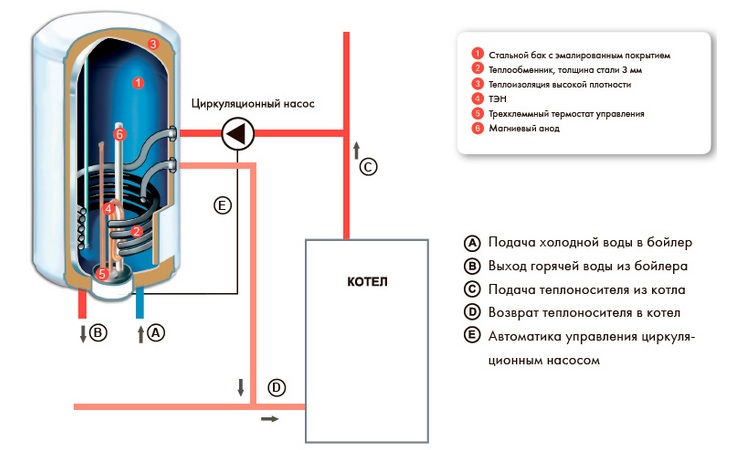
Today on sale you can easily find wall-mounted, floor-mounted and combined boilers from manufacturers from the most different countries. Thus, products of the ACV, Drazice and Alphatherm brands can be tabletop or wall-mounted and equipped with an electric heating element. If desired, you can find models in which the heating element can be connected separately and not be built-in.
Advantages and disadvantages
The advantages of combined indirect heating boilers rightfully include:
- long service life;
- no costs for purchasing additional fuel;
- the ability to operate equipment on any type of fuel, including solar energy;
- uninterrupted operation of a water heater with several water intake points without reducing performance levels.
- Sufficient power of the boilers ensures heating of water in a short time.
With all the above-mentioned advantages of combined water heaters, there are also some disadvantages. These include:
- the need to install additional devices, for example, a circulation pump;
- mandatory consideration of the boiler during design and approval engineering systems home even before purchasing it;
- dependence of the operation of the water heater on the operation of the heating boiler.
Thus, based on your financial capabilities and family’s needs for water, you can purchase exactly the equipment that will provide you with the comfort and coziness of living in your own home.
In modern construction, a very important component is not only the construction of the building frame, but also the creation of comfortable living conditions and the provision of all communications. One of the first on this list will be heating a living space. The presence of hot water is also an important detail. If it is not possible to implement centralized systems, autonomous equipment will come to the rescue. A combined indirect heating boiler is ideal for performing these specific tasks.
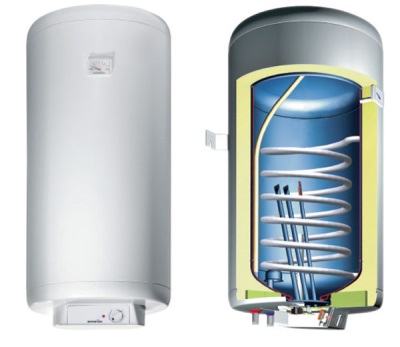
Peculiarities
Home distinguishing feature such units - use the heating system in the winter and be a direct heating boiler, bypassing the heating system in the summer.
- IN winter time When the heating is operating at full capacity, a single-circuit boiler operates together with the boiler. Hot water is supplied from it to the heat exchanger, and this is how the water is heated.
- In the summer, when there is no point in operating the boiler, the boiler can work independently. In order to ensure its operation, you can use both electricity and gas.
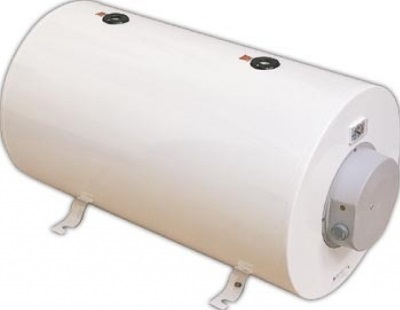
To provide a distribution system, the boiler is equipped with an additional controller that controls all processes. Of course, this will affect the price, but it's worth it.
Pros
Positive aspects Such an apparatus is considered, not without reason:
- long service life of the unit;
- there is no need to buy fuel reserves;
- it is possible to choose the energy on which the boiler will operate - electric, gas, solar;
- good power allows you to heat water quickly enough.
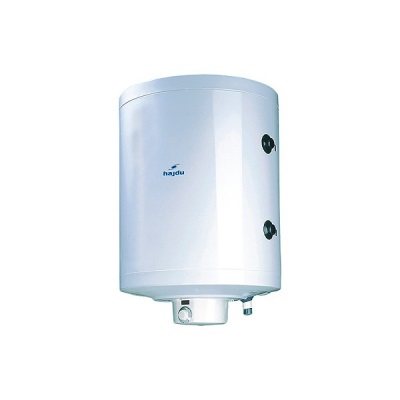
Cons
Along with a fairly impressive list of advantages, there are also disadvantages:
- there is a need to purchase additional devices. At least a circulation pump;
- the need to take into account the boiler at the design stage of the house;
- dependence on the proper functioning of the heating boiler.
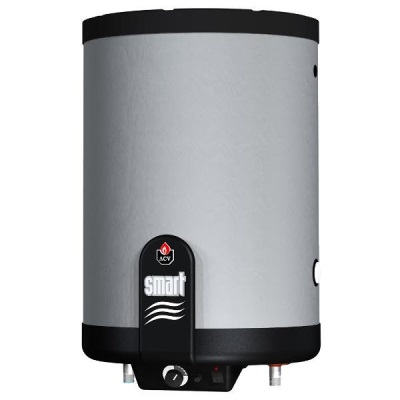
Operating principle
A combination boiler is an appliance that is capable of receiving energy generated by external sources. In terms of its structure, it is not that complicated: it is a container covered with a thermal insulation layer. The capacity can be from 20 liters to several cubic meters.
For the first time, such a device appeared inside chimneys around heating radiators; it was called a “coil”. Although it more closely resembled an indirect instantaneous water heater. Now such a coil is installed in the internal tank of the boiler. The flow carrying heat heats the water, which is used for hot water supply.
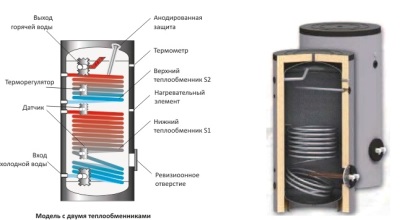
The advantage of a combined heating boiler is that it can be used not only in winter, when the heating season is in progress, but also in summer, incl. during problems on the highway that lead to shutdowns and interruptions in supply.
Types
Based on the conditions in which the device is used and what water flow is required, different water heaters can be installed with a different set of functions and properties.
- Flow type. The most famous modification is geyser. Their use is possible only if the problem of removing combustion products and installing additional ventilation is solved.
- Conventional electric boiler. If it is not possible to use gas-powered equipment, then a well-known device will heat the water.
- Double-circuit gas boiler. A significant disadvantage of such a system will be almost twice as much gas consumed. Savings can be achieved if you change the components to a simple single-circuit boiler and add a combination boiler to it. Otherwise, the system may provide a fairly high water flow.
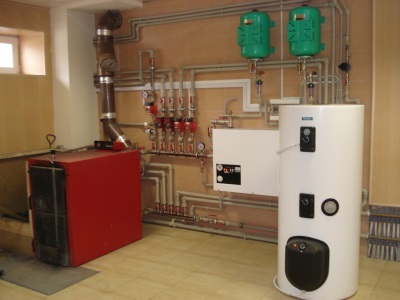
The most commonly used are floor-mounted indirectly heated combination boilers.
Popular manufacturers
The market in this segment is sufficiently represented wide range. The most popular manufacturers of combined indirect heating boilers:
- ACV (Belgium);
- Austria Email (Austria);
- Baxi (Italy);
- Drazice (Czech Republic);
- Oso (France);
- Stiebel Eltron (Germany);
- RUBOILER (Russia);
- Vaillant (Germany);
- Heatleader (Serbia);
- Lapesa (Spain);
- HAJDU (Hungary);
- Metalac (Slovenia);
- S-Tank (Belarus);
- Unitherm (Germany);
- SDM hotwater (Russia);
- GOPPO (Russia).
![]()
Prices
Prices for such products vary greatly. If you can choose a device made in Russia, Czech, or Spain at an affordable price. Although, if we talk about the prices set by the Spanish brand Lapesa, then it starts from 60 thousand rubles. up to a million, since they are the only ones in the world who protect weld from the inside. The average cost of a Belgian, German and French manufacturer is 300 thousand rubles.
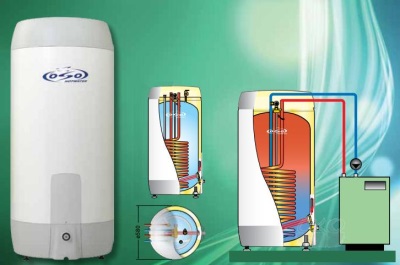
Types of harnesses
Piping an indirect heating boiler means connecting the boiler pipelines to the water supply. The operation of the system as a whole depends on how the installation is carried out.
There is one nuance here - the temperature that you set on the thermostat must be set higher than the temperature that is set in the heater! Otherwise, it will not be possible to heat the water to the point at which it switches to the heating circuit.
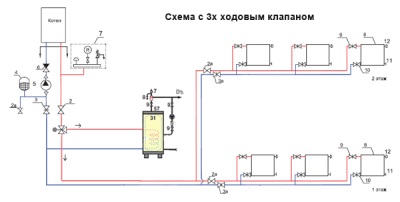
Trim with two pumps
Another piping option is with the parallel use of two pumps. One is mounted on the heating circuit, the other on the hot water supply. The control of the pumps, as in the first case, is entrusted to the thermostat. It is he who switches the operating mode.
The quality of heating remains at a high level.
The main thing is that when connecting two pumps, be sure to mount check valves at the exit of each. This is done to prevent mixing of counter flows inside the coolant.
If the heating system has many branches, such as a multi-circuit battery system or a separate branch for a heated floor, then it makes sense to use this type of piping. To avoid difficulties with a system in which each circuit is equipped with its own recirculation pump, a hydraulic distributor is used.
The water gun must balance the pressure in each direction and prevent thermal shock.
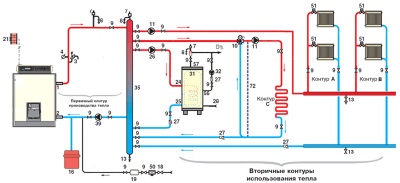
As for this type of strapping, difficulties are possible here. Therefore, it is better to entrust such a task as installation and subsequent adjustment of such a system to professionals.
- Get ahead of the maximum price you are willing to pay for your boiler.
- Determine the power of the unit. The heating rate directly depends on it.
- Select sizes and dimensions.
- Check the degree of protection and insulation.
- Consider everything service centers, whether they exist on Russian territory.
- Check the product warranty.
Before choosing a combined indirect heating boiler, be sure to familiarize yourself with the operating principles and general recommendations.
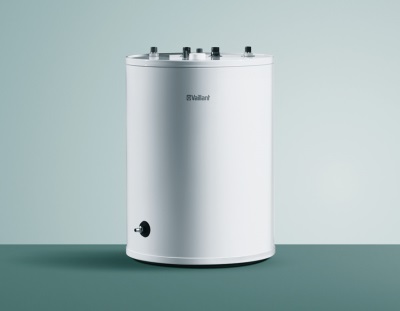
In the following video by Sergei Volkov you can see how to install a combined indirect heating boiler and why this device is so convenient and popular.
Those who spend a lot of time at their dacha should consider buying themselves a combination water heater, which combines the functionality of two devices at once:
Indirect;
Electric.
Such a device is an excellent option for acquiring autonomous system own hot water supply. Considering the quite affordable prices for such devices, this purchase will allow you to provide for your household without large investments. required quantity hot water for domestic purposes.
Combined boilers: operating principle
The combined device contains two heating elements at once:
Heating element for electric water heating;
Coil for indirect.
Depending on your tasks and current situation, you can use your device accordingly. For example, during the heating season, when your boiler is running, turn on indirect heating. This is a fairly convenient way to quickly heat water without extra costs, because water from the heating system will flow into the water heater coil, and then the temperature of the water will rise from it, filling the tank built into the unit. Thus, you will be able to seriously optimize your DHW costs, and they will be approximately the same as if you decide to install at your place.
Many people think that this reduces the efficiency of the boiler, but this is a mistaken opinion. Little water is needed to fill the coil, so any modern heating equipment has enough performance to handle this additional load.
But we live in a climate where a heating system is necessary in the winter, but not in the summer. So when you stop using your boiler for the summer months, you can easily switch your heater from indirect mode to electric mode. From this moment on, a heating element, which is connected to the power supply network, will be responsible for heating the water in it. Of course, during this period, electricity costs will be much higher, but your family will have year-round comfort at their disposal.
Combined indirect heating boiler: advantages
The main advantage of any indirect boiler is the low cost of maintenance. As you know, electricity prices are quite high, so many people do not buy an electric heater. But with a combined unit, you will have a tremendous opportunity to use electricity more economically throughout most of the year.
And although the price of such a device is not very low - today you can buy it for 15-17 thousand rubles - you should promptly assess your future costs of maintaining other types of water heaters. Even the minimum price varies between 20-25 thousand, so don’t think twice about buying a combined indirect heating model.
Another parameter for which you should buy a combined model is ease of use. You can connect such a unit yourself, without inviting a specialist and without spending extra money. This is quite convenient, because often it is the installation that causes certain difficulties for those who have just bought a water heater for their personal use.